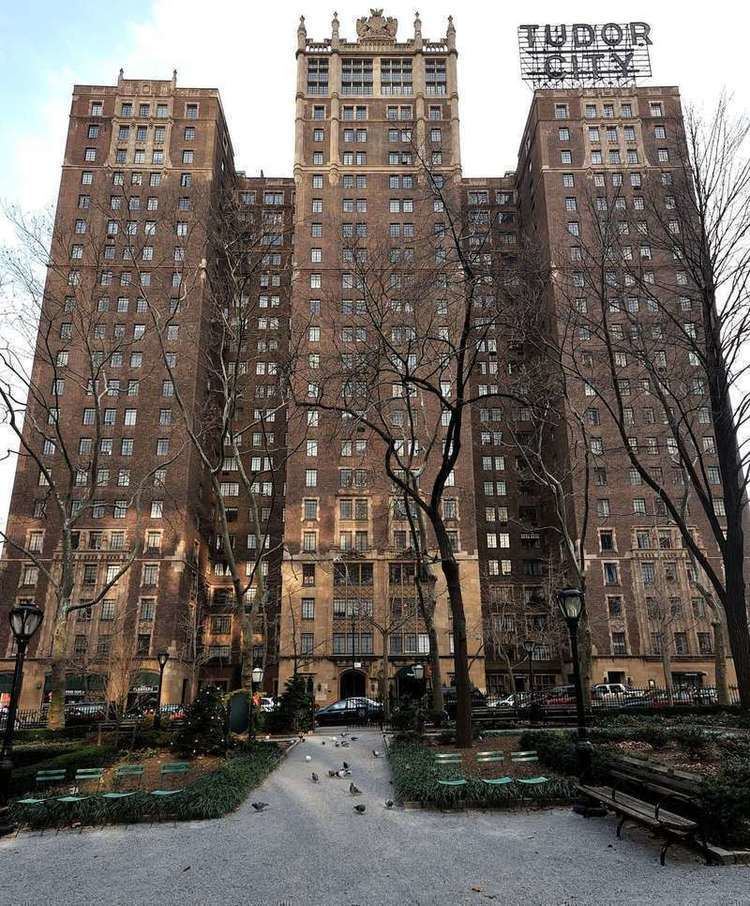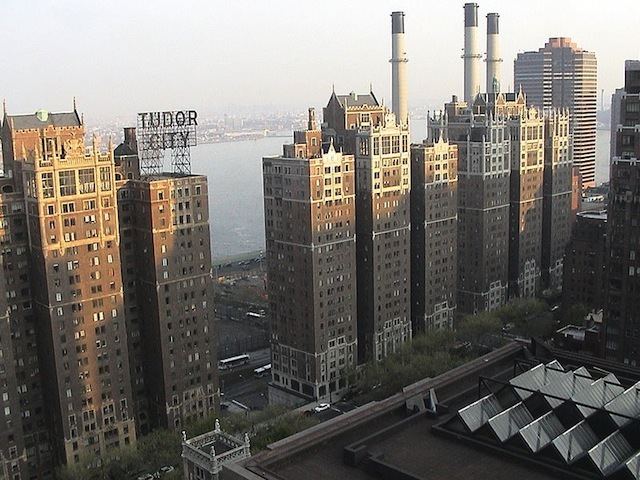 | ||
Tudor city the hidden middle class haven
Tudor City is an apartment complex located on the southern edge of Turtle Bay on the East Side of Manhattan in New York City, near Turtle Bay's border with Kips Bay. Construction commenced in 1927, becoming the first residential skyscraper complex in the world. It is bordered by 40th Street to the south, First Avenue to the east, Second Avenue to the west, and 43rd Street to the north. Tudor City takes its name from England's Tudor dynasty, which ruled from 1485 to 1603 and included King Henry VIII and Queen Elizabeth I.
Contents
- Tudor city the hidden middle class haven
- 5 tudor city place ph3 3 999m
- History
- Geography
- Buildings
- In popular culture
- References

5 tudor city place ph3 3 999m
History

Before Tudor City was constructed, tenements and slums dominated the area, which bordered a power plant and slaughterhouses, along First Avenue on the East River. The area was known as "Goat Hill" (goats and squatters ruled the area) and later "Prospect Hill". The area eventually developed into a shanty Irish community known as "Corcoran's Roost", founded by Jimmy Corcoran, in the 1850s. It later became known as a community with a high rate of violent crime and as a haven for waterfront thieves, most notably the Rag Gang, during the late 19th century.
In the 1920s, the real estate developer Fred F. French sought to lure tenants to Tudor City, his vision of an urban Utopia — a "human residential enclave" that boasted "tulip gardens, small golf courses, and private parks." The complex was built to bring in middle-class residents who had begun leaving Manhattan for the other boroughs and the suburbs. A 1994 feature in The New York Times reported:

Inspired by East Side reclamation projects like Turtle Bay Gardens and Sutton Place, French... [in 1927] began construction on the largest single residential project New York had yet seen. By 1932 he had finished nine big apartment houses and a hotel with a total of 2,800 units that soon accommodated 4,500 residents.

The historicist architecture of the buildings can be classified as neo-Gothic rather than Tudor or the related English revival styles Tudorbethan (Mock Tudor) and Jacobethan. An earlier 1920s residential development in Manhattan, Hudson View Gardens, also built for suburban appeal, made explicit use of such Tudorbethan features as half-timbering. Originally, two gardens flanked 42nd Street, with the south garden featuring a "miniaturized" 18-hole golf course. The area where the Tudor Gardens building (Number 2) stands today was the site of legendary tennis courts where the likes of Pancho Segura, Bobby Riggs, Rudy Vallée, and Welby Van Horn played exhibition matches. On at least one cold winter, the courts were flooded to create an ice skating rink for the community.

In May 1948, Claude Marchant, a "well-known dancer and teacher in the Katherine Dunham School of Dance," won a $1,000 judgement against the owners of Tudor City. Marchant, an African American, had been refused entry into the passenger elevator of one of the buildings, on the basis of race.
In the 1960s, the Fred F. French Company sold Tudor City to the Rabinowitz Corporation, which in turn sold it to the Helmsley Corporation in the 1970s. In May 1985, Harry Helmsley and Alvin Schwartz sold their remaining properties in Tudor City to Philip Pilevsky of Philips International and Francis J. Greenburger of Time Equities. The new owners quickly set about converting Tudor City into co-op apartments, as was happening across the city. Conversions were completed with little problem but when the real estate market and economy slowed in 1989-1994, some co-op prices dropped significantly, as owners and investors were concerned that the co-ops themselves would become insolvent. In April 2008, New York Magazine recalled the 1989 slump:
In 1988, Tudor City was named a New York City historic district. Preservation efforts leading up to the designation had started 10 years earlier when Harry Helmsley proposed building towers atop two parks within the complex.
Geography
The natural topography of the area features a granite cliff. Nearby East-west streets slope downward from Second Avenue to First Avenue. East 41st and 43rd Streets, however, slope upward to the clifftop and end at Tudor City Place. East 42nd Street slopes under Tudor City Place and down to First Avenue through a late 19th-century cut through the cliff, which was expanded in the mid-20th century to provide better access to the newly renovated headquarters of the United Nations.
With the cliff separating Tudor City from First Avenue below, it is accessible to vehicular traffic only via Second Avenue. A service entrance to 5 Tudor City Place is available from the "D" level, which is four floors below the lobby level. The service entrance exits at 40th and 1st Avenue allowing residents and building service staff to enter from 1st Avenue. A viaduct connects the two halves of Tudor City bisected by East 42nd Street, with staircases providing pedestrian access between 42nd Street and the complex. A separate staircase, known as the Sharansky Steps, connects Tudor City with Ralph Bunche Park and First Avenue.
Directly across First Avenue is the headquarters of the United Nations. Only a few apartments face the United Nations because when the area was completed in 1928 there were slaughterhouses to the east; most apartments were built facing the opposite direction because of the stench and filth that emanated. In the 1940s, the slaughterhouses were demolished and the United Nations Headquarters was built in their place. As of the early 21st century, the majority of apartments face inland parks and the Midtown skyline. Many apartments have good views of the Chrysler Building and Empire State Building.
Buildings
Tudor City's 15 buildings, comprising 11 co-op apartment buildings and four brownstones, are home to more than 5000 residents. The complex includes restaurants, a hotel, grocery, a gourmet deli, and convenience stores, a hair salon, laundries and dry cleaners, as well as three garden parks and a children's playground. Tudor City is also known for its rooftop TUDOR CITY sign overlooking 42nd Street.
In popular culture
Movies filmed in Tudor City include The Godfather Part III, The Peacemaker, Spider-Man and Spider-Man 2, Spider-Man 3, Splash, U.S. Marshals, Taxi Driver, and The Bourne Ultimatum. In the movie Scarface, a bomb is planted under the Governor's car at 5 Tudor City Place. In the movie Spider-Man, the top floors of Windsor Tower at 5 Tudor City Place were used as the exterior of Norman Osborn’s rooftop mansion. In the film The International, Clive Owen's character is seen entering beneath a canopy marked "Woodstock Tower," one of the Tudor City buildings; however, the subsequent interior is not actually Woodstock Tower.
On TV, Tudor City has appeared in the opening credits of The Jeffersons, where the moving van is seen moving in a somewhat blurred shot past the north park and Tudor City Manor on East 43 Street. The Law & Order episode "The Wheel" and the Law & Order: Criminal Intent episode "Death Roe" also had brief exterior scenes filmed at the complex. Tudor City exterior shots were also recently seen on "Ugly Betty" in the episode entitled "The Butterfly Effect-Part 2" after Daniel and Betty left the United Nations photo shoot at 34 mins, 13 seconds into the show. The rooftop of one Tudor City building is the filming location for Neal Caffrey's rooftop patio on the television series White Collar.
